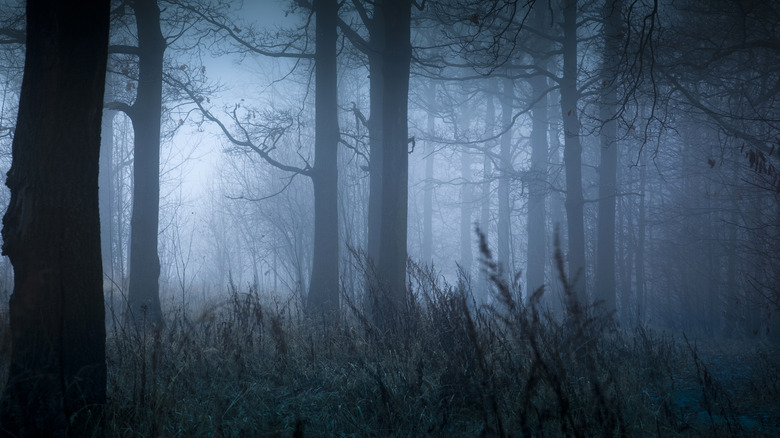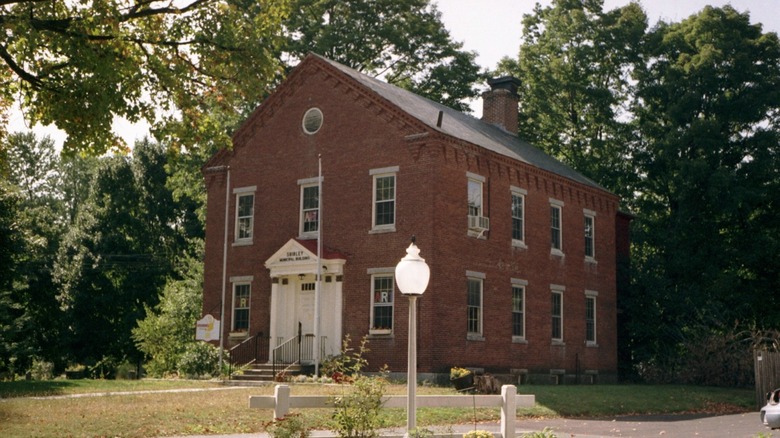The Bizarre Legend Of The New England Cryptid, The Egopantis
Why is it that so many cryptids, backwoods beasties, and lurking creatures from local tales have such lame names? Bigfoot: That's a bit too on the nose — it's got big feet. Mothman: A man that's also a moth. Goatman: A creepy man that's also a goat. Frogman: A man that's also a frog. The Jersey Devil: That one guy from "Jersey Shore" called "The Issue" or something. Maybe "Chupacabra" sounds exotic and cool unless you speak Spanish, in which case "goat sucker" isn't too intimidating. Olgoï-Khorkhoï the "Mongolian Death Worm" is better, until you realize it's probably just a snake. And then there's (drumroll) the Egopantis: A name that will never make sense no matter what way you slice it.
Here's the scene, as Atlas Obscura and the "Paranormal 60" podcast describe: Back in the late 1700s one Nathaniel Smith was fishing in the woods near Shirley, Massachusetts, a tiny town with a population of less than 7,000 as of 2022. As the story goes, some "mighty and terrifying" creature had been hanging out in the area being generally scary. Smith, musket in hand, kicks in the door to the local Bull Run Restaurant and brandishes the head of the beast, which allegedly took 10 days to die. "I did it!" he cries. "I slayed the ... uh ... Egopants — I mean pantis! I wounded it, and it charged at me from across the brook. And then I delivered the killing blow. You see? Just don't touch it, because the paint is still drying."
What is the Egopantis, anyway?
To be fair, no one really knows what the — let's call it "head" — hanging on the wall at Bull Run Restaurant in Shirley, Massachusetts really is. It kind of looks like a giant platypus, maybe a chunk of carved wood with some fur lining and marbles stuck on it for eyes, a failed attempt at taxidermizing someone's enormous leather shoe, or — yeah, who knows? Atlas Obscura says an expert from the American Institute of New York City, Elizabeth Ryan, was "baffled" by the head. But it's apparently been hanging in its exact, current resting spot over Bull Run Restaurant's fireplace for over 200 years.
No one knows the exact year it arrived — when Nathaniel Smith valiantly rescued locals from its bill. Lee and Mary Guercio purchased the Bull Run Restaurant in 1946, and they drew the name from the eponymous Civil War battle. In 1962, Lee told The Boston Globe that it came from a Massachusetts man named Arnold C. Dickenson. We do know that the tavern has been around since 1740 and looks like a pretty sweet old, wooden, cozy watering hole if you're ever in the area. Beyond that, we've only got tall tales.
And to be sure: Those tall tales have served Bull Run Restaurant well. Aside from podcasts on sites like "New England Legends," blog posts on sites like that of writer M.A. Kropp, and entries in roadside attraction sites like Roadside America, the Egopantis has its own dedicated Bull Run Restaurant page. In full campy, self-aware, jolly fashion, the page dispels naysayers, writing, "Doubt flickers, rises, recedes. Legends grow. In 'boots off' comfort around our fireplace, YOU are the sole judge, as you have seen the Egopantis. And SEEING is BELIEVING! LONG LIVE THE EGOPANTIS!"
Debunkers and investigators — give up on the Egopantis now
Every source repeats the same condensed story about the Egopantis. M.A. Kropp's blog post repeats the tale, relayed by a waitress at the Bull Run Restaurant: There's a nearby brook called the "Mighty Mulpus;" Nathaniel Smith shot to kill; no more Egopantis. And in this iteration of the story, a quirky local eating a cheeseburger swears there's still an Egopantis hanging around nearby. All we need is Mulder and Scully and we've got the perfectly bizarre setup for an "X-Files" episode.
Despite all the goofy fun surrounding the Egopantis, the Bull Run Restaurant describes at least one attempt to debunk the story, which we briefly mentioned earlier. An unnamed military captain apparently wrote to the Smithsonian Institution and American Institute in New York City to inspect the Egopantis head. Elizabeth Ryan from the latter investigated the alleged creature using "abundant and formidable encyclopedic volumes" but could find no clear zoological origin. Then there was the writer of the aforementioned Boston Globe article who visited and wrote about the Egopantis.
[Featured image by John Phelan via Wikimedia Commons | Cropped and scaled | CC BY-SA 3.0 DEED]
A small town with a big tale
Shirley is located about 30 miles northwest of Boston and seems to be thriving, Egopantis or not. In 2022, the town had a poverty rate of around 2.1%, lower than America as a whole at the same time (11.5%, per the U.S. Census Bureau). If scouring its grounds for the mythical creature isn't up your alley, there are hiking trails, boating launch sites, a museum, and a town recreation area with tennis courts, a pool, and a playground maze.
The town was the birthplace of composer Oliver Holden, who famously wrote the "Coronation" hymn used by Civil War soldiers. It's also home to the cottage of actor Will MacKaye, whose son, conservationist Benton, founder of the Appalachian Trail. Shirley isn't the only region in Massachusetts to allegedly harbor a cryptid, either. There's the Dover Demon of its eponymous town — a white, alien-like creature that walks on four limbs. And then there's the troll-like pukwudgies of the Freetown State Forest, and of course Bigfoot sightings across locations like Hockomock Swamp, Bridgewater Triangle, and the Berkshire Mountains.
In the end, does the truth of the Egopantis really matter? No. It's just funny when people put an Uncle Sam hat on it, as musician Sophie B. Hawkins shows on her website. Sometimes that's enough. So check your ego (and maybe pants) at the door, and enjoy. And if you're still curious, here are some more cryptids that are said to roam the United States.
[Featured image by Bob Burkhardt via Wikimedia Commons | Cropped and scaled | CC BY 3.0]



